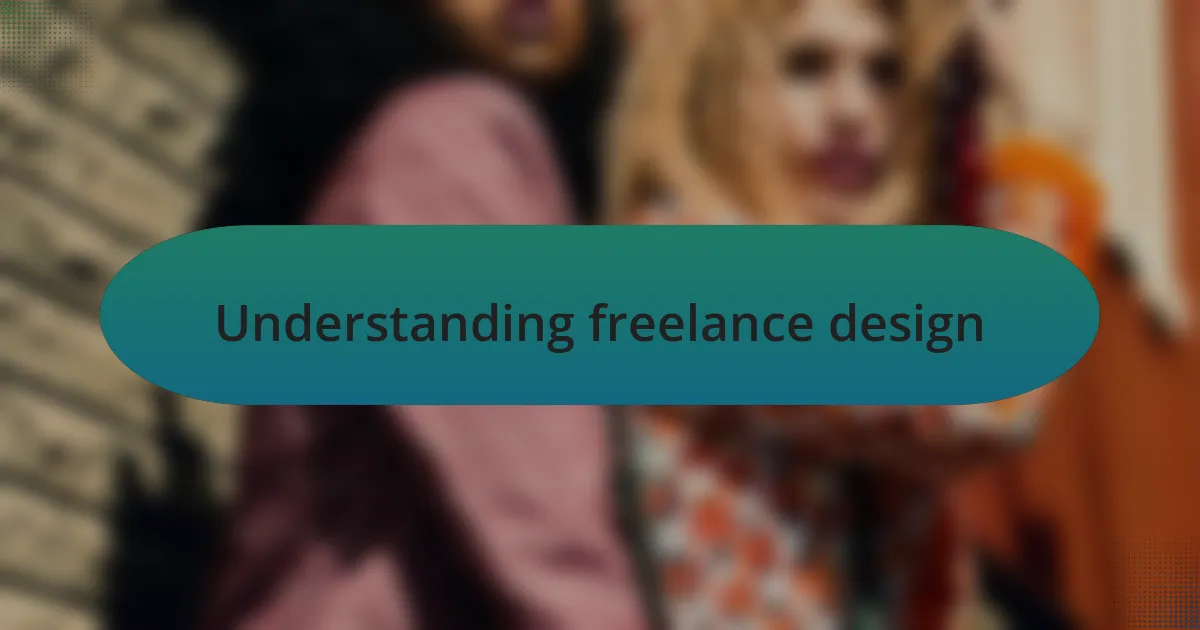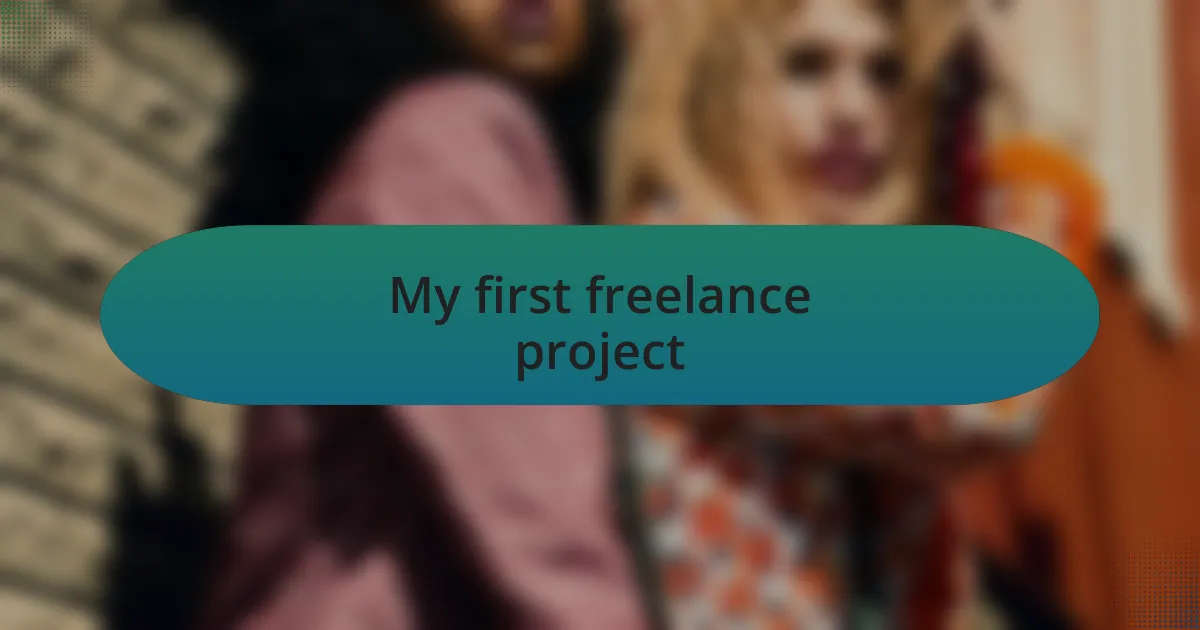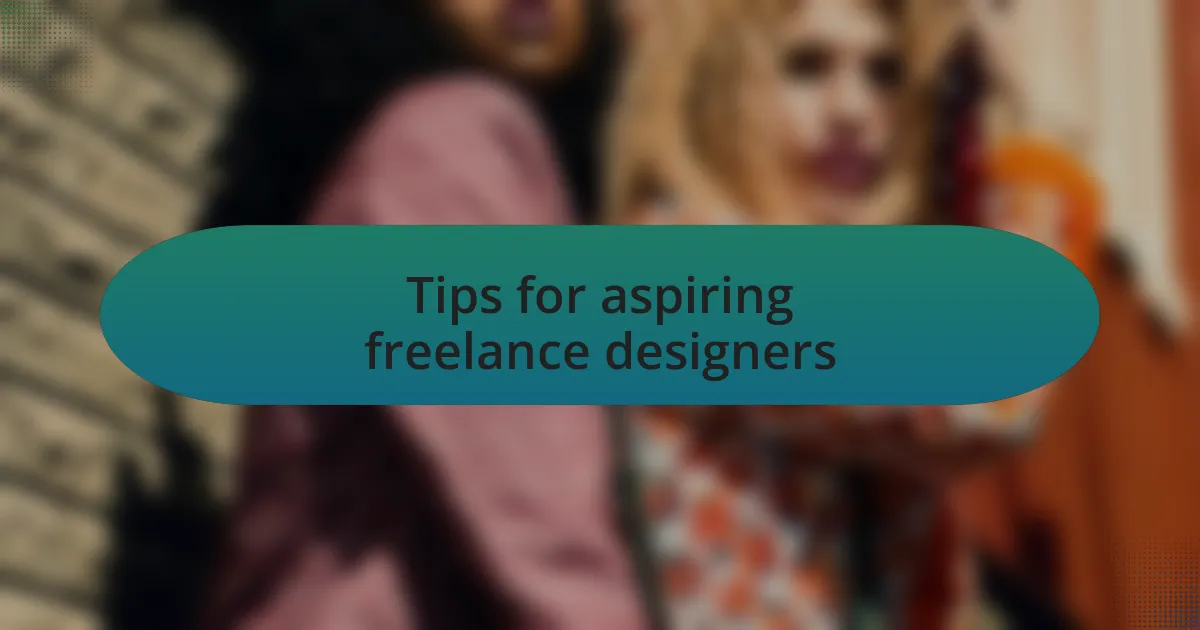Key takeaways:
- Building a personal brand enhances visibility and client connections in freelance design.
- A strong portfolio should reflect unique style and adaptability through diverse projects.
- Networking is crucial for collaboration and career growth; maintaining relationships can lead to future opportunities.
- Effective client communication fosters trust and ensures project alignment and satisfaction.

Understanding freelance design
Freelance design is not just a job; it’s a lifestyle that offers freedom but also demands discipline. I remember my first month as a freelancer, the thrill of setting my own hours was exhilarating. Yet, I quickly learned that self-motivation could be elusive. Have you ever found yourself staring at a blank screen, paralyzed by too many choices? It’s a common struggle that taught me the importance of a structured schedule.
When I transitioned to freelance design, I serendipitously discovered the importance of building a personal brand. I wasn’t just showcasing my work; I was telling my story. Clients are drawn to a designer’s unique perspective. I often ask myself, what makes my work stand out? This reflection helped me embrace my individuality, allowing me to connect with clients on a deeper level.
Networking became my lifeline in the freelance world. I recall attending local design meetups where I felt out of my element, but each conversation was a stepping stone. It made me realize that relationships in this industry can lead to collaborations that shape your career. So, who are you reaching out to today? Your next big opportunity might just be one connection away.

Importance of personal branding
Building a personal brand as a freelance designer is essential for standing out in a competitive market. I vividly recall when I updated my portfolio, infusing it with my distinct style. The moment I optimized my online presence to reflect my design ethos, I noticed a shift in client inquiries. Have you ever felt that surge of confidence when someone recognizes your unique touch? That recognition can be incredibly empowering.
What truly matters in personal branding is authenticity. I learned this firsthand when I shared my design journey on social media, including both successes and struggles. The vulnerability resonated with my audience, helping clients see me as a relatable figure rather than just a designer. This connection enriched my client relationships, making each project a personal investment rather than just a transaction. Isn’t it fascinating how honesty can foster trust?
Moreover, personal branding opens doors beyond client work. I remember when a well-known designer featured my work in their blog because they were drawn to my brand story. That exposure led to new clients and opportunities I had never imagined. Have you considered how your story can elevate your visibility? By embracing and sharing your narrative, you not only boost your brand but also pave the way for unforeseen collaborations and growth.

Building a solid portfolio
Building a solid portfolio is like crafting a visual résumé that showcases your unique design identity. When I first started out, I felt overwhelmed by the sheer number of styles I could adopt. It wasn’t until I focused on my favorite pieces, the ones that truly resonated with my artistic vision, that I began to see the value in curating rather than collecting. Have you ever felt that a single piece could tell a deeper story about who you are as a designer?
As I expanded my portfolio, I made a conscious effort to include projects with diverse techniques and themes. Each project brought its own set of challenges, pushing me to grow while demonstrating my adaptability to potential clients. I remember a project where I created a collection inspired by sustainable materials. That experience not only enriched my skill set but also aligned with a growing demand for eco-conscious design. It’s intriguing how a single project can bridge personal values and professional appeal, isn’t it?
Additionally, seeking feedback from fellow designers played a crucial role in shaping my portfolio. Sharing my work with trusted peers opened my eyes to perspectives I hadn’t considered. I recall a pivotal moment when a mentor pointed out the narrative flow of my portfolio; I hadn’t realized how the sequence of my works could impact viewer engagement. Engaging with others shows the collaborative spirit of the design community and can elevate your portfolio in ways you might not expect. What insights have you gained from sharing your work with others?

Networking in the design industry
Networking in the design industry is an essential skill that can propel your career forward. I vividly remember my first industry event, thick with nerves and excitement. Approaching seasoned designers felt daunting, but striking up conversations about shared interests turned strangers into invaluable connections. Have you ever realized how unlocking a single conversation can lead to new opportunities and collaborations?
During one particular networking event, I met a fellow designer who was passionate about textile innovation. Our shared enthusiasm led to a fruitful collaboration that expanded both our portfolios. What struck me was not just the immediate benefits but the lasting friendship that emerged from it. This relationship opened doors to exhibitions and workshops I didn’t even know existed. Isn’t it fascinating how genuine connections can create a ripple effect in your career journey?
I’ve also learned the importance of maintaining these relationships over time. A casual catch-up over coffee or a simple social media message can keep the momentum going. I often reach out to past collaborators to exchange insights or even just share inspiration. Building a network isn’t just about gaining, it’s about giving, and nurturing those bonds has enriched my creative life immensely. How do you see your network evolving as you grow in your design career?

My first freelance project
Landing my first freelance project was a thrilling experience that felt both exhilarating and nerve-wracking. I remember receiving a call from a small boutique looking for a unique dress design that captured their brand essence. My heart raced at the thought of working on a real project, but I was equally terrified of disappointing them.
As I dived into the design process, I found myself pouring my creativity into every sketch. Each iteration felt like a reflection of my growing confidence. I vividly recall the moment when I showcased the finished design to the client; the joy in her eyes made all the late nights worth it. Isn’t it remarkable how a single project can boost your passion and determination?
Looking back, that project taught me valuable lessons about client communication and the importance of understanding a brand’s vision. I realized how essential it is to listen carefully and ask the right questions. Have you ever thought about how a simple inquiry can reshape your entire design approach? This experience laid the groundwork for my professional journey, transforming my fears into a genuine love for freelance design.

Challenges faced as a freelancer
Taking the leap into freelancing comes with its fair share of hardships. One of the most daunting challenges I faced was managing my time effectively. Early on, I found myself overwhelmed by the mix of client expectations, deadlines, and my aspiration to deliver top-notch work. Have you ever felt like there just aren’t enough hours in the day? I definitely have, and learning to balance projects while maintaining a healthy work-life dynamic was a tough but crucial lesson.
Financial instability can be a persistent shadow for freelancers. Unlike a regular job, I didn’t have a steady paycheck coming in each month. There were moments when I worried about how I would pay bills if work dried up. I remember a particularly lean month when my heart raced every time I opened my email, hoping to find a project waiting for me. It’s a nerve-wracking feeling, but it pushed me to seek out diverse opportunities and build a more resilient business model.
Another challenge that surfaced was the isolation I felt while working alone. Unlike the collaborative environment of an office, I was often tucked away at my desk, missing the creative energy of teamwork. Have you ever realized how much a little interaction can spark inspiration? I certainly did, and it became clear that I needed to carve out time for networking events and communities, allowing me to connect with fellow designers and rekindle my creative spirit.

Tips for aspiring freelance designers
When starting out as a freelance designer, one invaluable tip is to build a strong portfolio. I remember how my first attempts felt awkward, showcasing projects I wasn’t entirely proud of. It’s natural to worry if your work isn’t “good enough,” but focusing on quality over quantity set me on the right path. Ask yourself: what unique style do I want to present to potential clients? This reflection can help you curate a collection that truly represents your talent.
Networking should be at the forefront of your strategy. Initially, I was hesitant to reach out to others in the industry because I feared rejection. However, attending local design meetups transformed my perspective. Engaging with fellow creatives not only filled the void of isolation but also opened doors to collaborative opportunities and referrals. Have you considered how your next client might be just one conversation away? Connecting with others can spark ideas and provide fresh business leads.
Don’t underestimate the importance of effective communication with your clients. Early in my freelance journey, I struggled with articulating my design choices, leading to misunderstandings. I soon realized that being transparent about your process helps build trust. So, when discussing a project, consider asking your clients about their vision and expectations—this dialogue not only clarifies the project scope but also fosters a sense of partnership. How often do you think your clients feel more connected and happy when they are part of the process? I found that simply involving them made a world of difference.